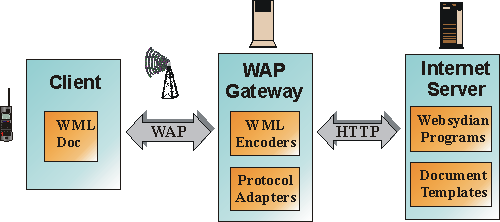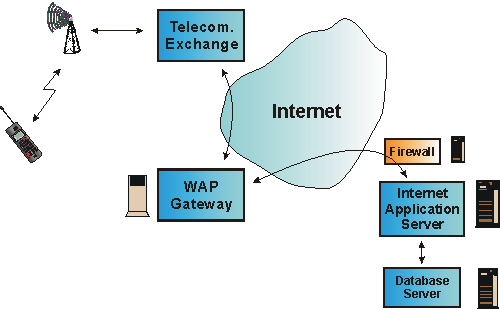|
|
Users Guide | Patterns Reference | WebsydianExpress | Search |
|
|
Users Guide | Patterns Reference | WebsydianExpress | Search |
Imagine that you could access your business applications from the mobile phone that you always carry with you. That you – even from remote areas – could look up information in your application databases and submit requests updating your system.
You can! – in fact WAP applications made by Websydian are already in operation
WAP applications can be run from everywhere – the user only needs is a mobile phone supporting WAP. Data are shown in the display of the phone and navigation in data and entry of information is done through the 12-key key pad. Seconds after you have submitted a request, data will be in your application available for employees, customers, and business partners.
WAP applications may be made so that they can be accessed by everyone or they can be restricted to a designated group of users only. The number of mobile phone users is growing exponentially and is estimated to reach one billion within 3 years (Gartner Group, IDC). So, the number of potential users of your WAP applications is huge.
Websydian together with Advantage Plex have proved to be a strong tool for development of HTML-based applications for the internet. The model-based approach provided by Advantage Plex gives you a very productive environment in which you are in control, and Websydian allows you to integrate your internet applications smoothly with your back-end data and processes. Plenty of customers have already built secure, reliable, and integrated internet applications with Websydian and Advantage Plex.
All the characteristics making Websydian such a strong tool for Web development are carried over when Websydian is used for development of WAP applications. And, the Session, Security and Audit facilities implemented by Websydian are reused in WAP development with no modifications at all.
Scandinavian Garment Services (SGS) – a distributor of clothes in Scandinavia – already experienced the power of Websydian used for WAP development. Within weeks, SGS had a WAP application ready – a solution that made it possible for their lorry drivers to enter delivery status information from a WAP mobile phone directly into the SGS back-end system.
Some kind of session handling is needed by most Internet applications in order to recognize the different users of the system. Session handling in Websydian is implemented by server-based session handling where session records are created in a Session table on the application server. This is as opposed to the client-based cookies approach implemented in many Web applications, which require the Web client to download a cookie on the client machine.
The WAP protocol does not support cookies, and therefore another solution needs to be found for WAP development. The answer very well becomes server-based session handling as already implemented by Websydian.
Security is a critical issue for most organizations moving their applications to the Internet.
Application security in Websydian is provided by the Integrity module implementing digital signatures on all hidden fields submitted to the Web server. In this way, Websydian will detect all attempts to change hidden status data like changing the Session ID in order to run the application as another users getting his authority to the application. In addition, Websydian contains a User Management module including password control, which can be used to restrict the number of users having access to the applications.
Both the Integrity module and the User Management module can be used as-is for development to the WAP platform.
WAP operates with WML (Wireless Markup Language) which very much looks like HTML just designed for low-bandwidth, small display devices. In this way, WML documents are displayed by the micro-browser implemented by mobile phone displays just as normal HTML documents are displayed by a Web browser. The WAP protocol itself supports low-bandwidth communication by removing a lot of the overhead introduced by the HTTP protocol.
It is therefore no coincidence that Websydian is such an excellent tool for WAP development. When Websydian is used for WAP, all basic concepts are kept unchanged and as with Websydian little concern needs to be made about the underlying technology. For example is the generation of WML pages (Decks) for the mobile micro-browser based on Document Templates in exactly the same way as the generation of HTML pages in Websydian.

WML Decks shown in the micro-browser of the mobile phone are generated from Document Templates. During the generation of a WML Deck, all replacement markers in the template are substituted with data values.
When implementing a WAP application, the WAP protocol maps very well to the HTTP protocol that is used for internet communication. As shown in the figure below, the WAP device communicates with a WAP/HTML gateway which in turn communicates with a Web server.

WAP requests are sent from the Client (e.g. a cellular phone) to a WAP gateway through the phone net. From the WAP Gateway, the request is routed on to the Web Server to be received as a normal HTTP request. Similarly, WML documents are generated at the Web Server and sent to the Client through the WAP Gateway.
Generated WML documents are submitted to services provided by the HTTP protocol and forwarded to the client through the WAP gateway, while the client will submit HTTP requests to the Web server through the gateway.
By using Websydian, the WAP protocol is made transparent to the developer. Websydian supports generation of WML documents as well as receiving WAP client requests and in this way, all development is done in a single Advantage Plex/Websydian environment where the developer does not need to concentrate about low-level technology. In the same way, the developer writes his programs with no regard to whether the application will be installed on an NT or iSeries Web server communicating with a NT or iSeries application server.
Before generated WML documents can be shown by the micro-browser on a mobile phone and before WAP requests can find their way to the company server updating the application database, it is required that a certain technical infrastructure is in place. This technical infrastructure is outlined in the figure below:

The figure shows how application data and requests find their way back and forth between the mobile phone and the Application servers.
A request sent from a WAP phone to a business application passes the following steps:
Communication between the Telecommunication Central, the WAP Gateway, and the Web Server must be set up by the telecommunication provider and the provider of the WAP Gateway. Once this has been done, Web Server programs can be implemented receiving and acting upon WAP requests and generating new WML decks in response.